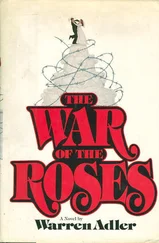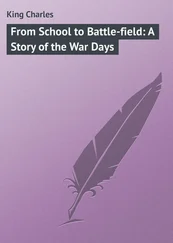We are going Khrestishche village, north from Slovyansk. Already from several hundred meters away you can see huge clouds of smoke, black as tar. The separatists burned down their checkpoints when they saw Ukrainian forces approaching. Burning tires created a circle of fire. With every gust of wind you can feel waves of heat. When I cross the wall of smoke, I see what has scared the separatists. APCs are approaching from the north. There are about ten of them, some have Ukrainian flags. Some are taking the road, others are moving toward us through the fields. They are accompanied by special units and snipers. Helicopters are flying over our heads. This is not the only checkpoint that is in flames today.
“The antiterrorist operation may have started in earnest,” I tell my colleague.
Slowly, we approach the APCs. We show our documents to a man in uniform. He explains that they are a special forces unit.
“How long do we have to wait for you? We have been dragging along like this for half an hour,” he says with a smile, as if all this were a media event.
The APCs are slowly approaching the burning barricade. There is a car coming from the direction of Slovyansk. The soldiers are waving their hands, telling the driver to stop. He must have been spooked, so he is lurching left and right. Finally, a warning shot is fired.
“Halt,” shouts one of the soldiers.
The car stops and a man gets out slowly, with his hands up. The soldiers tell him to lie on the ground and they search him. He is clean, so they let him go.
In the end the APCs and the soldiers pass by the checkpoint. There is nobody there. Suddenly and out of nowhere an elderly man appears on a bike. He stands next to the burning barricades as if nothing has happened.
“What do you want?” asks a startled soldier.
“I want to get there, home,” he points westward.
“So go!” The soldier gives in.
Panic has broken out in the city. Just a few hours ago people were walking around and now the streets are completely deserted. Everyone is afraid that the Ukrainian forces will enter the city and regular combat will begin. There are no pedestrians. The city is patrolled by “greens” with rifles and grenade launchers. The shops closed in the blink of an eye. There is nobody near the SSU building. The separatists’ APCs patrol the neighborhood until nightfall.
When I come back to the checkpoint a few hours later, the Ukrainian soldiers are gone, and the checkpoint has been taken back by the separatists again. The former simply disappeared without any struggle. A “green” is trying to convince me that Right Sector has been here. He claims they are ready to fight off an attack, although they only have old rifles, a few grenades, and some Molotov cocktails. They are probably the ones who took to their heels when they saw Ukrainian forces moving toward them. They are safe now, so they can show off how fearsome they are. Their men have noticed that the Ukrainian forces withdrew toward Izium in the Kharkiv region. The headquarters of the antiterrorist operation is located there.
“Probably about a hundred Spetsnaz troops have stayed in the forest,” a “green” says.
Why did the Ukrainian forces leave their positions? As always, nobody knows. On this very day quite a few contradictory explanations emerged in regard to the events that had taken place northeast of Slovyansk. First came the leaks from the military sources. Supposedly, it was the threat of Russian intervention that halted the operation. Also on this day Russia began to hold its military exercises near the Ukrainian border (claimed to have been planned a long time before). Then, Viktoria Siumar, the deputy secretary of the National Security and Defense Council, announced that stage one of the operation had just ended. Now the next stage was on its way—the siege of the city.
Defeats in the East
That was the first “active phase” of the antiterrorist operation announced by the Ukrainian National Security and Defense Council. After the Russian annexation of Crimea and the total lack of any opposition to the progress of the Russian Spring, Kiev desperately needed some sort of success. Interior Minister Arsen Avakov’s declarations that “the reaction will be very severe” were not taken seriously any more. He was dubbed the “Facebook minister,” because, as was commonly believed, he was active only there. The phrase “The Interior Minister has made information available on his Facebook page”—like the expression “The European Union is concerned about the situation beyond its eastern border”—became objects of ridicule.
It is necessary to demonstrate that the Ukrainian side controls the “rebellious” regions, even if it is a pure PR strategy. Ukrainian officials have made serious declarations. On April 13, Acting President Oleksandr Turchynov proclaimed that the Ukrainian state wouldn’t remain passive about events in eastern Ukraine. “We have done everything to avoid casualties, but we are ready to resist all attempts at invasion, destabilization and terrorist activities with weapons in our hands. The NSDC has made the decision to launch a large-scale antiterrorist operation using the Ukrainian armed forces. We will not let Russia repeat the Crimean scenario in the eastern Ukrainian regions,” declared Turchynov. Two days later he announced that the operation had begun in earnest. “On Tuesday morning the antiterrorist operation began in the northern part of the Donetsk region. It will be carried out gradually, responsibly and in a balanced manner, because its goal is to protect Ukrainian citizens,” he stated. One of the strangest of military operations had officially begun.
The first attempts to recapture Kramatorsk and Slovyansk ended in humiliating defeats for the Ukrainian forces, although the shooting was rather sparse. On April 16 near Kramatorsk six Ukrainian infantry fighting vehicles appeared. Their job was to retake the city. However, city residents showed up, got in their way, surrounded the vehicles, and didn’t let them pass. As a precaution, they blockaded the road with a marshrutka , a private minibus. Standing by the vehicles, dozens of people are trying to convince the soldiers not to “shoot at their own.” This is absolutely sufficient for the soldiers to abandon their plans. According to the Defense Ministry, “representatives of Russian subversive and terrorist groups” instigating the local population were spotted among the blockaders.
It is interesting that initially the ministry claimed that no such an incident had ever taken place, and photos and videos were just “fakes.” But they could no longer be called a lie after a plethora of pictures and videos appeared in the media and on the internet. The Defense Ministry then admitted that the IFVs were from Kramatorsk and belonged to the Ukrainian Armed Forces.
“As a result of the siege extremists took over the vehicles and the convoy moved towards Slovyansk. At 3 p.m. the convoy approached one of the administrative buildings in the center of Slovyansk. Armed people in military uniforms are nearby, but they have nothing to do with the Ukrainian Armed Forces,” you could read on the Ministry’s Facebook page. But what happened to the soldiers? Nobody knows. The separatists were boasting that they had joined them, but judging by the fact that no Russian media managed to interview them, this was just wishful thinking. It is known, however, that the vehicles ended up in the separatists’ hands without any struggle.
While the confusion about the personnel carriers was going on, in Donetsk some armed militants from Oplot, a pro-Russian organization founded in Kharkiv, took over the City Council. Its employees were evacuated. Moments later in Yenakiieve, the birth place of Yanukovych, pro-Russian demonstrators captured the City Council, too, and detained its officials inside. Skirmishes broke out in Mariupol, when militants attacked a Ukrainian military unit. One person was killed and a dozen were wounded. In the end, the Ukrainian forces managed to hold on, but at that point the city was under the separatists’ control. According to Oleksandr Zakharchenko, a member of Oplot, the purpose of taking the buildings was to force the government in Kiev to organize a referendum about the status of the Donetsk region.
Читать дальше








![Theresa Cheung - The Dream Dictionary from A to Z [Revised edition] - The Ultimate A–Z to Interpret the Secrets of Your Dreams](/books/692092/theresa-cheung-the-dream-dictionary-from-a-to-z-r-thumb.webp)



